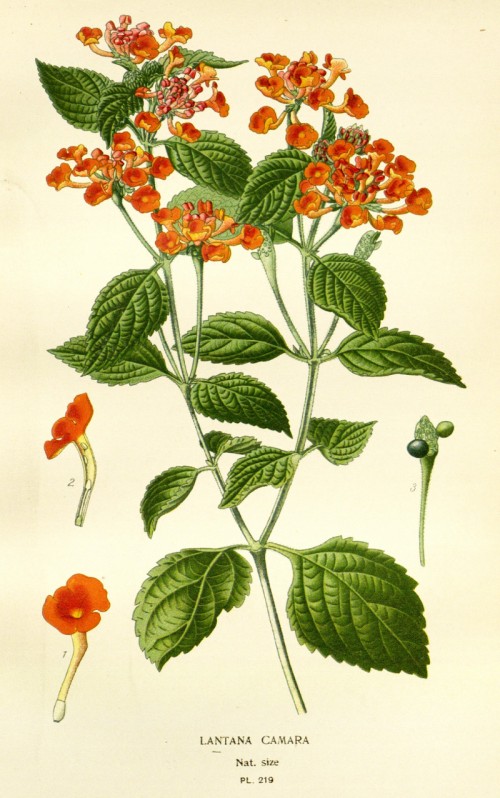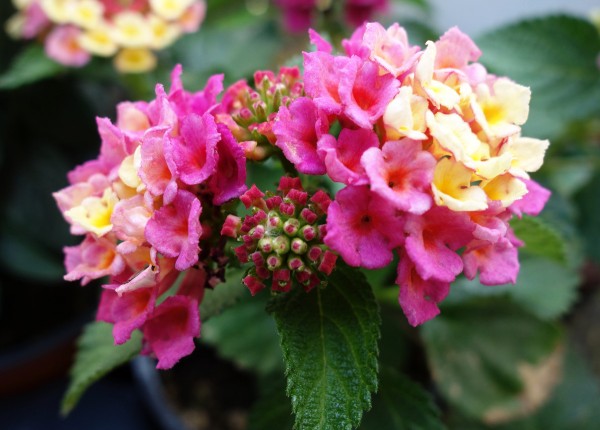Lantana camara L. - Verbenaceae - common lantana, wild sage, red sage, yellow sage, Wandelröschen
Evergreen much-branched shrub, up to 3m high, native to tropical America, cultivated as ornamental and naturalized worldwide; leaves opposite, ovate to ovate-oblong; flowers orange or yellow, turning to red or scarlet later; berries blue-black when ripe.
„A number of varieties, of indefinite consatancy in flower colour have been recognized by some authors; some of these, seen from the area, are as follows: var. camara : flowers orange-yellow, turning red or scarlet; var. flava (Medic.) Moldenke: flowers yellow; var. rubella Moldenke: flowers pink; var. sanguinea (Medic.) L.H. Bailey: Flowers opening saffron yellow but changing to bright red later; var. aculeate (Linn.) Moldenke: Plants with conspicuous prickles; var. alba Moldenke: Flowers white.“
http://www.efloras.org/florataxon.aspx?flora_id=5&taxon_id=200019370
„The plant has been used in many parts of the world to treat a wide variety of disorders. Lantana camara found use in folk remedies for cancers and tumours. A tea prepared from the leaves and flowers was taken against fever, influenza and stomach-ache…
The phytochemistry of L. camara has attracted considerable interest mainly arising from the presence of toxic compounds in certain races. However, a number of phytochemical reports do not specify the variety investigated and others refer to various taxa using varietal epithets. The ease with which this plant hybridises
introduces other variables making comparisons difficult. Lantana camara sensu latu is a complex of many closely related plant taxa and it is considered here as one species complex… Triterpenes… In a detailed study of toxic taxa of L. camara, it was found that lantadene A and B predominated (up to 2.2% of the dry weight of leaves and stem; approx. ratio 2:1)… Some taxa of L. camara are toxic to ruminants and poisoning has been reported from Australia, India, New Zealand, South Africa and the Americas. Losses are of particular concern in Australia and India. Of 29 taxa found in Australia, eight have been found to be toxic to livestock. All the toxic taxa contained lantadene A and B and both 80 and 200 mg/kg, respectively have been shown to be toxic to sheep.“
[Lantana camara L.(Verbenaceae), Ghisalberti, E.L., Fitoterapia, Vol.71(5), 2000, 467-486]
„In Lantana camara… floral colour change was correlated with largely quantitative changes in floral
scent chemistry… However, these changes did not occur uniformly in all floral volatiles or in the most
abundant compounds [trans-beta-ocimene 50%/48%, beta-caryophyllene 14%/15%, alpha-humulene 7%/9%], and were not tightly correlated with the presence or removal of nectar. Rather, they were limited to
two separate biosynthetic groups of volatile compounds: linalool and its furanoid and pyranoid oxides (monoterpenoids), and a suite of common aromatic esters, alcohols and aldehydes (benzenoids).“
[Concerted Changes in Floral Colour and Scent, and the Importance of Spatio-Temporal Variation in Floral Volatiles., Raguso, R., Weiss, M.R., Journal of the Indian Institute of Science, Vol.95(1), 2015, 69-92]
http://journal.iisc.ernet.in/index.php/iisc/article/viewFile/4545/4847

Step,E., Bois,D., Favourite flowers of garden and greenhouse, vol.3, t.219 (1896-1897) [D.G.J.M. Bois]
http://plantgenera.org/species.php?id_species=584109

